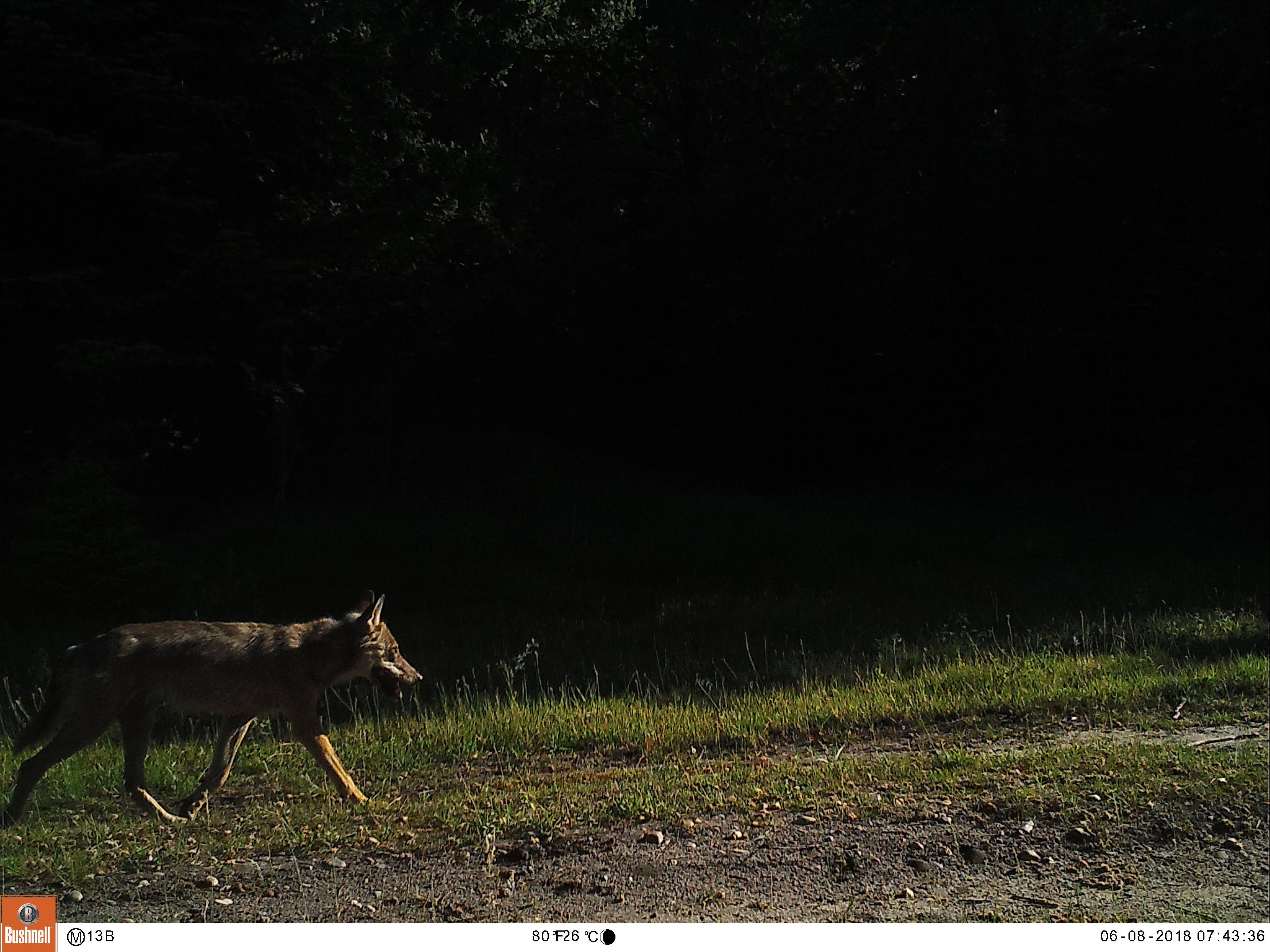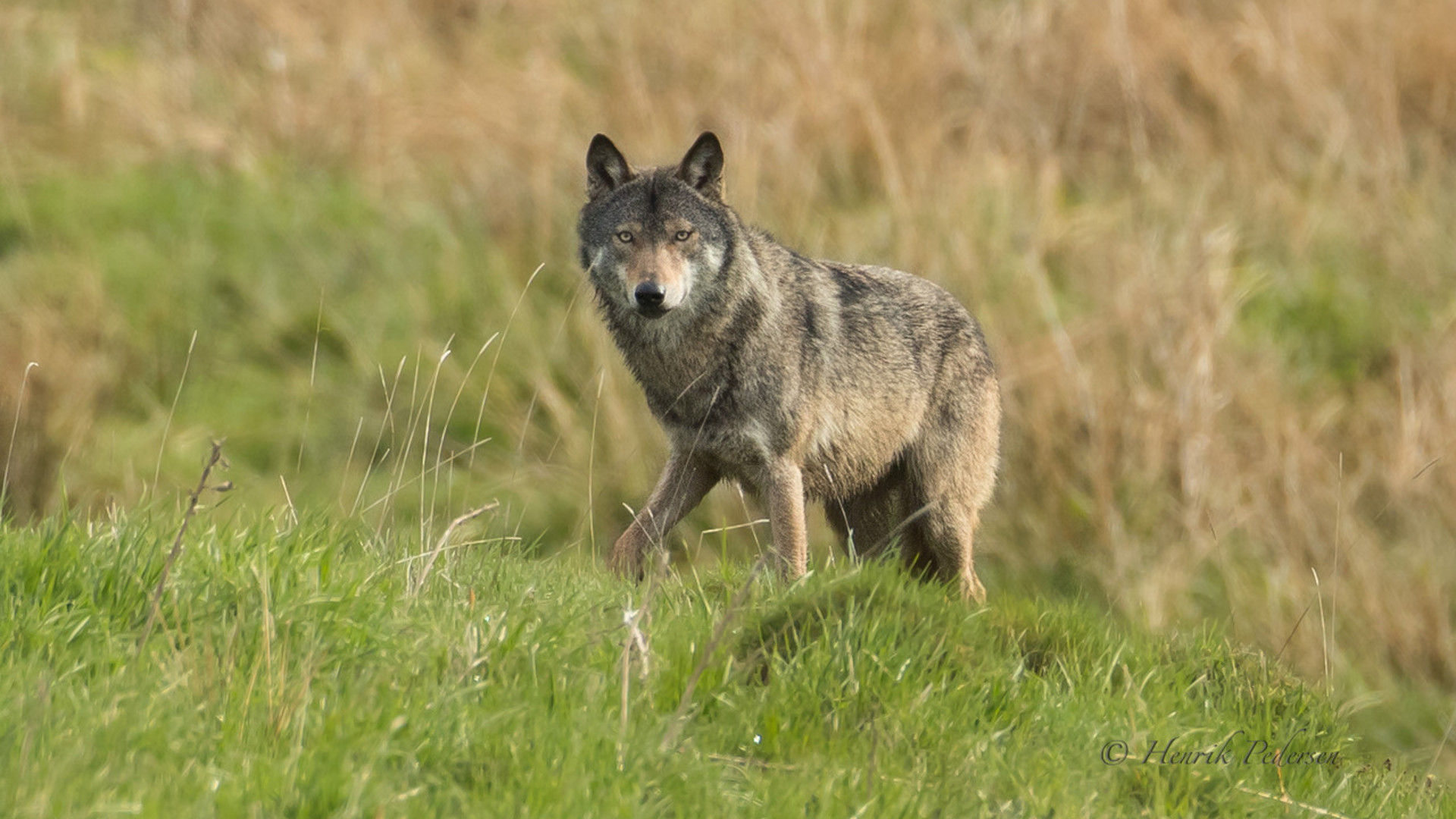JUTLAND, Denmark— A patchwork quilt of green-and-brown agricultural fields and small gray cities unfurls across the flat, sprawling landscape of Denmark’s largest peninsula. It’s April 2018, and an adult female gray wolf — believed to be the first female wolf to come to the small Nordic country in more than 200 years — lopes along the perimeter of a farmstead that abuts a brush of forest in Jutland’s west-central region.
Woodland is a rarity in Denmark, a country largely cultivated by humans. The small forest, owned by a local farmer, accommodates a large herd of red deer — a steady source of energy for the wolf and others in her small pack, which began accumulating members in 2012. The forest also provides two sources of income for the farmer: Hunters pay to kill on his land, while the government reimburses him for any damage the deer cause to the forest.
The she-wolf wanders alongside a dusty field being tilled by a large tractor, till she notices a man sitting in a truck at the edge of the field. She quickens her gait, keeping her eyes fixed on the man. He, in turn, lifts a rifle and fires. The bullet hits her, and she’s later found dead, setting off a firestorm of worldwide media coverage and eventually leading to the man’s conviction for killing the protected animal.
This event, caught on camera by two naturalists, illustrates why wolves have been extirpated here and across the rest of Europe: Many people have grown to view them as adversaries, threats to their safety and way of life. They say this is a reason to kill them.
But there are signs that the tide is turning. The European Union is now strongly encouraging human-wolf coexistence by offering full compensation to farmers across member states for livestock lost to wolves and other predators. The EU is also funding nonlethal ways to keep wolves at bay, such as fences and livestock dogs.
This new EU-wide initiative is a step toward more nonlethal wolf management, says Dr. Hans Peter Hansen, a social scientist at Aarhus University who is studying the human relationship to wolves in rural Denmark. Nonlethal management strategies are seen as a more modern, ethical management scheme, but also as something that is difficult to implement due to wolves’ lasting, mythic legacy as an adversary of people.
“The man-versus-wolf conflict is one that’s ingrained in the human psyche to an extremely hateful and hostile extent,” he says. “Dealing with it will require more than money for lost sheep and fences.”
Hansen says Denmark, with its new wolf pack living near humans, is in the midst of an experiment that could help develop a revolutionary strategy for wolf management.
His secret: Give locals a voice.
Since August 2017 residents of a small town in West Jutland have gathered regularly to meet with Hansen and other scientists from Aarhus University as part of a project that invites townsfolk into an open dialogue about wolves in their community and how they want to live with them.
While Hansen says his sole motive has been to facilitate discussion about wolves, this project appears to have cascading effects, according to Cathrine Schrøder, who is also from Aarhus University and involved in the project.
“What we found was that residents had a generally open position on wolves, and could identify both positive and negative aspects about having them live in their town,” she says. “It created perhaps a sense of empathy and responsibility toward them.”

The most recent meeting took place during the last week of November, when I joined about 25 residents at their community center on a dark, raw evening. They had gathered that night to discuss the outcomes of the project’s previous meetings and where to take it next. As they arrived each scientist greeted them personally, with more hugs doled out than handshakes in what appeared to be a mutually trusting relationship. “An increased trust in scientists was a major outcome of our project,” Schrøder told me.
Hansen, Schrøder and two other experts sat down with the residents to a hearty meal of roasted turkey legs, gravy and potatoes, chatting about their families and jobs and Christmas plans. Once they filled their stomachs, the group was joined by two wolf biologists and began figuring out where to take the project next. They also tried to determine if there’s any hope they can develop a useful strategy for wolf coexistence in Denmark, tailored to the needs of their heavily rural community of farmers, hunters and families.
Farmers and hunters have traditionally opposed wolves’ presence because of the potential for financial losses from predation on livestock and game. Families, especially mothers, also tend to have a negative view of wolves because they fear the animals may harm their children or pets. Perceiving wolves as a threat often leads people to kill them illegally — even though scientific studies have largely suggested that wolves pose a fairly low threat to human lives and livelihoods in most places. In fact, killing wolves can possibly lead to more livestock deaths, as I have previously reported for The Revelator.
“People have legitimate concerns about the wolves,” Hansen told me over coffee at a food market in Copenhagen a week prior to the November meeting. “At our first meeting many people came as stakeholders, defending their interests. But I think this is a fundamental problem in society in general: We’ve cultivated stakeholders so deeply that we’ve eroded the commons.” What’s happened, he says, is that there are so many divisions that a society cannot properly identify common ground or its responsibility for protection.
Other scientists across Europe agree that public support and cooperation are key in creating and implementing effective, science-based wolf-management strategies that minimize killing and conflict. “Without public support or at least an approach in which you work together with those most affected by the presence of large carnivores,” keeping the population of wolves healthy throughout Europe will remain difficult, says Katrina Marsden, a biodiversity expert at adelphi, an environmental public policy consultancy in Berlin.
In most European countries — Denmark included — the lawmakers responsible for making rules about wolves across multiple countries have been informed by interest groups represented in urban capitals, despite the fact most people in major cities live far from them. Across the continent a wildlife-protection measure called the EU Habitats Directive provides varying levels of protection for wolves and other wildlife across their ranges. In Denmark wolves are assigned the highest level of protection under the law, and killing them is prohibited unless they create an emergency situation.
What’s lacking in Denmark and many other European countries are clear management plans with set goals and repercussions for illegal wolf kills, says Hansen. As one part of management, Danish biologists highly recommend tracking the wolves with GPS collars. They say that could help them to better monitor the animals’ movement and behaviors — allowing them to better prevent and respond to human-wolf interactions. The biologists been able to secure funding and permitting for the tracking project, and are in the midst of planning capturing activities, Aarhus University wildlife biologist Peter Sunde told me.
Some other aspects of wolf management have yet to be resolved, most notably how to punish people who strike out against them. According to news reports, the man who killed the she-wolf in May received a light prison sentence and had his guns confiscated.
“Many people, including me, are surprised that he was allowed to keep his hunting license,” Hansen says. “The revocation of which would send a clear message to others about breaking the rules.”
As the community meeting wound down after nearly four hours of discussion, residents brought their visions of a Danish wolf-management plan to the fore. One proposed regulated wolf-based tourism that could prevent harm to both wolves and people while creating a revenue stream for the community. Another proposed further investigation into innovative, nonlethal wolf-attack prevention measures, in addition to further investment in existing measures like livestock fencing.
As the residents aired their ideas around the room, one thing was clear: They had warmed up to wolves, no matter their starting position, and wanted the meetings to continue.
“While the idea of living next to wolves sometimes scares me a bit, I have gained a lot of respect for them,” one woman told me at the end of the evening. “And I think we can find a good way to live with them if we stick to this project in the years to come.”
© 2018 Erica Cirino. All rights reserved.
Previously in The Revelator:
What Do Wolves Need to Thrive?


